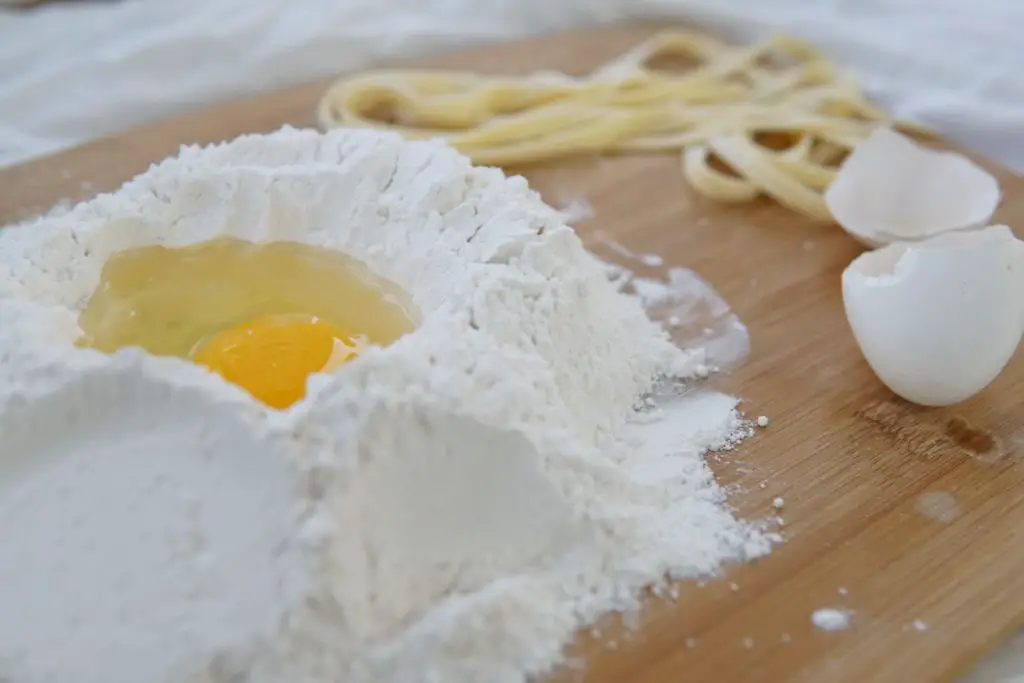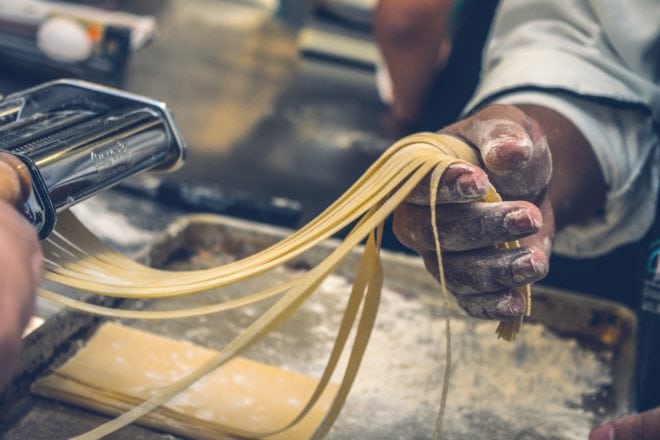Table of Contents
What is Pasta?
Pasta is a staple food of traditional Italian cuisine dating back in 1154 in Sicily. It is made from an unleavened dough of wheat flour mixed with water or eggs and formed into sheets or various shapes, then cooked by boiling or baking.
Pasta may be fresh (pasta fresca) or dried (pasta secca). Most dried pasta is produced commercially but it could also be made at home like what we’re going to feature here today.
Fresh pasta is traditionally produced by hand, sometimes with the aid of a pasta maker.

Click the image to check price on Amazon
Pasta comes in many forms; long, tubes, flat, sheet, miniatures, and stuffed. The names of pasta shapes and types vary by region in Italy. However, for the sake of simplicity, we will do a long, flat pasta.
As a Category of Italian Cuisine
Pasta also refers to the variety of dishes made with it and is considered a category in Italian cuisine. Both fresh and dried pasta are classified into three kinds of preparation.
- Pasta asciutta (or pastasciutta) is the cooked pasta plated and served with a complementary side sauce or condiment. An example would be the spaghetti with pesto rosso.
- Pasta in brodo is a class of pasta dish wherein the pasta is part of a soupy dish. An example would be the risotto.
- Pasta al forno is the third class wherein the pasta dish is baked in an oven. An example would be the lasagna.
Dried Pasta vs. Fresh Pasta
Fresh pasta is usually made with flour and eggs. Since it contains eggs, it is more tender and only takes about half the time to cook than dried pasta. Delicate and thin sauces are preferred for fresh pasta in order to let the taste of fresh pasta rise above. Fresh pastas do not expand in size after cooking.
Fresh pasta can also be made without eggs. Semolina wheat flour and water are mixed together and shaped usually into orecchiette or cavatelli.
Dried pasta is usually made in factories that produce large amounts and shipped to far places because these have longer shelf-life and would not spoil easily. Dried pasta is dried at a low temperature for several days to evaporate all the moisture allowing it to be stored for a longer period.
Dried pastas are best served in hearty dishes like ragu sauces, soups, and casseroles. Once it is cooked, the dried pasta will usually grow to twice its original size.
How To Make Pasta
Ingredients:
- 2 cups of unbleached flour
- 3 large eggs
- ½ teaspoon of salt

Procedure:
- Make a mound of flour on a clean countertop or cutting board and create a well in the center.
- Put the eggs and salt into the well.
- Using a fork, whisk the eggs without disturbing the flour.
- Then add flour into the egg mixture gently, a little amount at a time until you have incorporated all the flour.
- Using your hands, blend the mixture well until you form a ball. If the dough seems too dry, add a little more egg mixture. If the mixture is too wet and sticks to your fingers, rub your hands with flour and continue forming the dough into a ball.
- Knead the pasta dough by pushing it down and away from you with the palm of your hand. Turn and fold the dough over itself and knead again. Repeat until the dough is smooth. This may take 7 minutes.
- Divide the dough into 3 equal parts and form each into a ball. Cover each dough with a towel and let it rest for 15 minutes.
- If you don’t have a pasta maker, a rolling pin will work just fine.
- Flatten one of the dough balls with the palm of your hand until it’s about 1/2 an inch thick and no wider than the slot of the pasta maker. Gently feed the dough into the slot while turning the handle of the pasta maker. Gently hold the dough as it goes out of the pasta maker so it would not tear.
- Continue passing the dough through the pasta machine until it becomes 1/16 inch thick.
- Most pasta makers come with an adapter that can cut the dough. But if you don’t have a pasta machine, you may use a knife to cut it.
Drying The Pasta
Fresh Pasta
There are three ways that you can do to dry fresh pasta.
- Immediately after cutting the dough, hang the pasta on a dowel or on a clean clothes rack or hanger. The pasta can be used right away or you can keep them for a week.
- Using a food dehydrator, place the strips of fresh pasta in a single layer, without touching or overlapping each other, onto the drying trays. Dry for 2 to 4 hours at 135ºF. Once dried, you can store it in airtight containers.
- Lay the pasta flat on a dry towel or paper towel, in a single layer, without touching or overlapping each other. Cover it with a screen and sundry for a few days. Once dried, you can store it in airtight containers.
Cooked Dried Pasta
There are times that you have prepared too much pasta that throwing them out is wasteful. But with a food dehydrator, you can dry cooked pasta for future use.
For long pastas like spaghetti or linguini, it would be better if they are arranged like a nest. An easier way to do this is to use a bowl that you usually use for one pasta serving and put the pasta in it enough for one serving. Then place them on the drying trays,
Dry at 115ºF at least overnight. As they dry, simply turn the portions over to allow for more air circulation. Dried pasta will be hard and crisp. It will look and feel much like the raw versions.
Rehydrating Dried Cooked Pasta
- Drop the desired amount of pasta in the boiling water and give it a stir.
- Spaghetti rehydrates almost instantly. By the time you give it a stir, it is already limp and ready to use.
- Remove from the water and serve.

Final Thoughts
Making pasta requires only three ingredients: flour, egg, and salt. Mix, knead, cut, and dry — you now have a ready to cook pasta. And if you made too much, don’t fret because you can still dry cooked pasta and rehydrate them for future use.

